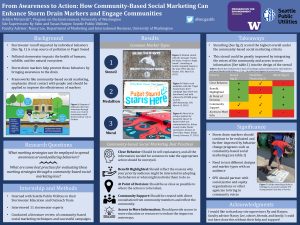FROM AWARENESS TO ACTION: HOW COMMUNITY-BASED SOCIAL MARKETING CAN ENHANCE STORM DRAIN MARKERS AND ENGAGE COMMUNITIES
Stormwater runoff is the biggest ongoing source of pollution in the Puget Sound. Rainwater falls on our roofs, yards, and streets and collects pollutants such as soaps, pet waste, litter, fertilizers, and gasoline and flows into storm drains that lead directly to local waterbodies and eventually the ocean. Most of these sources of pollution are found in everyday items and it is difficult to regulate these behaviors. Municipalities try to prevent these behaviors through storm drain marking, which is the process of labeling drains with visual indicators that urge the public to not dump. This study aimed to identify which types of marking strategies were the most effective in changing behaviors and how to improve storm drain marking based on the principles of community-based social marketing (CBSM). To accomplish this task, I interviewed stormwater managers from municipalities across Western Washington and employees at Seattle Public Utilities about their storm drain marking program. I also did online research on the framework of CBSM and identified common elements of successful campaigns to form criteria to score different types of markers. Findings show that the most common types of marking are stenciling, plastic adhesive markers, and murals. Stenciling was most effective at changing behaviors, according to the CBSM criteria, and could be improved by being tailored to its community. In conclusion, storm drain markers should be evaluated and improved with CBSM so marking programs can be more effective in preventing pollution and reinforcing desired behaviors to protect Puget Sound and its inhabitants.
